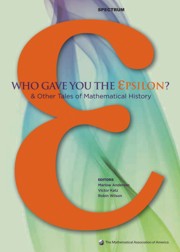Book contents
- Frontmatter
- Introduction
- Contents
- Analysis
- Geometry, Topology and Foundations
- Foreword
- Gauss and the Non-Euclidean Geometry
- History of the Parallel Postulate
- The Rise and Fall of Projective Geometry
- Notes on the History of Geometrical Ideas
- A note on the history of the Cantor set and Cantor function
- Evolution of the Topological Concept of “Connected”
- A Brief, Subjective History of Homology and Homotopy Theory in this Century
- The Origins of Modern Axiomatics: Pasch to Peano
- C. S. Peirce's Philosophy of Infinite Sets
- On the Development of Logics between the two World Wars
- Dedekind's Theorem:√2 × √3 = √6
- Afterword
- Algebra and Number Theory
- Surveys
- Index
- About the Editors
A Brief, Subjective History of Homology and Homotopy Theory in this Century
from Geometry, Topology and Foundations
- Frontmatter
- Introduction
- Contents
- Analysis
- Geometry, Topology and Foundations
- Foreword
- Gauss and the Non-Euclidean Geometry
- History of the Parallel Postulate
- The Rise and Fall of Projective Geometry
- Notes on the History of Geometrical Ideas
- A note on the history of the Cantor set and Cantor function
- Evolution of the Topological Concept of “Connected”
- A Brief, Subjective History of Homology and Homotopy Theory in this Century
- The Origins of Modern Axiomatics: Pasch to Peano
- C. S. Peirce's Philosophy of Infinite Sets
- On the Development of Logics between the two World Wars
- Dedekind's Theorem:√2 × √3 = √6
- Afterword
- Algebra and Number Theory
- Surveys
- Index
- About the Editors
Summary
I have recently been recalling that about twenty-five years ago, when I first came to settle in this country, I was invited to participate in the celebration of the opening of the Mathematics Building, Van Vleck Hall, at the University ofWisconsin. On that occasion I learned a new American word, namely “banquet”, which has a totally different meaning in the United States from the meaning that it has in Britain. But more importantly, I must recall the immense respect I felt for some of the after-dinner speakers who were able to make the recounting of an event last much longer than the event itself. So I'm very conscious of the fact that in attempting to recount to you the history of algebraic topology in this century, I must not make the recounting of this history last longer than the history. In fact, I must telescope it very dramatically, one might almost say, abruptly. So I apologize in advance that much of the treatment will be necessarily very superficial. I would like to start off with the first epoch which is up to 1926. And here the inspiration for homology theory comes from the work of Poincaré.
Poincaré, during a period earlier than the one I'm thinking of, had already invented or discovered, according to your philosophy, the fundamental group. But he published a series of papers in which he was studying what we would call algebraic varieties, the configuration of points in higher-dimensional Euclidean space given by polynomial equalities and inequalities; and he was looking again at what we might call vector fields and generalizations of vector fields on such varieties.
- Type
- Chapter
- Information
- Who Gave You the Epsilon?And Other Tales of Mathematical History, pp. 148 - 156Publisher: Mathematical Association of AmericaPrint publication year: 2009



